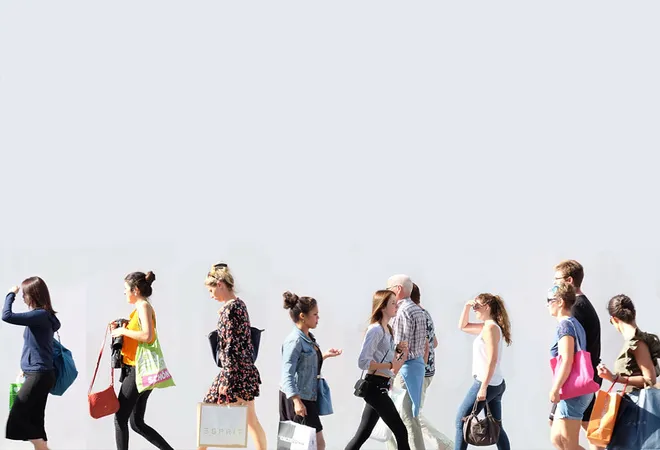
The COVID-19 pandemic is changing our lives in multiple ways — ways that we, as a society, will come to detect, understand, and accept many years from now. It has transformed the way we work, eat, shop, do business, and even
the way we cast our vote. Previous research has indicated that consumer behaviour changes in times of crisis. Epidemics in the past, such as SARS and MERS, showed the trend of
‘economic elastic behaviour’ where people curtailed their spending and focused largely on essential goods. Along with curtailed consumption, people also paid more attention to the price and origin of the product, not only shaping what consumers bought but also where they bought it from.
Consumption is not only habitual but also
contextual. Context matters and ad hoc disasters like earthquakes, hurricanes, wars, and pandemics like the current one fall into the most important and least predictable category. Along with factors like risk perception and risk attitude,
three major factors lead to the formation of new habits. These are public policy, technology, and demographics.
Public policy tends to shape the ease with which consumers can buy any particular product and indulge in any desired transaction. It also determines if there are any alternatives available. One of the major advantages of air travel — which is its efficiency — may get offset by the increased time required to prepare for air travel, security checks, COVID tests etc., which then may push people to shift to other means of transport, especially for shorter distances. Changes in technology continuously
transform wants into needs. The mobile phone and internet have not only become needs by themselves but are also pushing through a whole set of new behaviours like online shopping, paying bills online, gaming, GPS navigation, etc.
Changing demographics shape consumer behaviour. For example, the ageing population of advanced economies will have different patterns for spending on recreation, wealth preservation, and health compared to a population with a lower mean age.
One of the major advantages of air travel — which is its efficiency — may get offset by the increased time required to prepare for air travel, security checks, COVID tests etc., which then may push people to shift to other means of transport, especially for shorter distances.
These new habits and the factors leading to their creation are
moderated by personality characteristics, culture, geography, and time period. The likelihood of a habit’s retention is determined by the extent to which a person is exposed to that particular environment. It takes anywhere between
18 to 254 days for a new habit to form, with
66 days being the average time taken.
Research conducted in this sphere lists some emerging trends of consumer behaviour caused by the current crisis.
One major emerging trend has been the accelerated rate of digital adoption. There has been a ‘
digitalisation of buying’ with greater use of e-commerce touch points. This looks to increase with the regulations on physical movement and distancing set to continue. Technology and digital media platforms are set to play a greater role in reaching out to consumers, creating a buzz, facilitating transactions and retention of customers. The shortage of goods and the constraints imposed has unleashed a vast amount of
improvisation amongst the consumers, trying to do their best with what could be sourced. Through such creative solutions, new ways of consumption are invented and the old traditional ways get discarded. There is also a shift towards a simpler buying pattern with consumers focusing on
basic needs and essentials rather than on luxury goods. Even the more well-off expressed their disapproval for excess consumption and went for more sustainable and local offerings.
Pent-up demand is another consumption trend that emerges in times of crises. Consumers postpone purchases, especially of large durables like automobiles, which then gets released whenever conditions become more normal or there is a window of respite from the crises.
Technology and digital media platforms are set to play a greater role in reaching out to consumers, creating a buzz, facilitating transactions and retention of customers.
The pandemic has forced upon all of us new ways of doing things, modifying existing practices, and transforming entire ecosystems, and that too for a considerable length of time. Therefore, the next big question in modelling consumer behaviour is: Will habits formed during the crises continue or will people return to their old routines once conditions change? Consumers will shift to new ways of doing things if they are ‘
more convenient, affordable, and accessible.’ Streaming services like
Netflix, Disney, and Prime are examples of such shifts in consumer behaviour with a better and more accessible alternative coming along. In a survey done by
Numerator Insights Data (2021), reflecting on food consumption habits in a post-COVID scenario, 32 percent of the respondents felt that they will visit bars and restaurants more frequently than pre-COVID times, while 23 percent expected themselves to continue with the habit formed in the COVID period, i.e., going out for food a lesser number of times. With regards to modification of habits around ordering or take-out of food, 18 percent felt that they will continue at a greater frequency, while 19 percent believed that their habits will change and return to the pattern of pre-COVID times.
An interesting aspect of human behaviour is the
coming back of habits or necessities that are given up as a recreation or a hobby. It is highly likely that day-to-day activities of our current world such as in-store shopping, travelling for work, dining at restaurants, etc. may get converted into recreational one-off activities and hobbies. It will be interesting as well as critical to identify which of these habits are the modern-day equivalents of hunting and fishing, to trace the path human society takes in a post-COVID scenario.
The views expressed above belong to the author(s). ORF research and analyses now available on Telegram! Click here to access our curated content — blogs, longforms and interviews.
 The COVID-19 pandemic is changing our lives in multiple ways — ways that we, as a society, will come to detect, understand, and accept many years from now. It has transformed the way we work, eat, shop, do business, and even the way we cast our vote. Previous research has indicated that consumer behaviour changes in times of crisis. Epidemics in the past, such as SARS and MERS, showed the trend of ‘economic elastic behaviour’ where people curtailed their spending and focused largely on essential goods. Along with curtailed consumption, people also paid more attention to the price and origin of the product, not only shaping what consumers bought but also where they bought it from.
Consumption is not only habitual but also contextual. Context matters and ad hoc disasters like earthquakes, hurricanes, wars, and pandemics like the current one fall into the most important and least predictable category. Along with factors like risk perception and risk attitude, three major factors lead to the formation of new habits. These are public policy, technology, and demographics. Public policy tends to shape the ease with which consumers can buy any particular product and indulge in any desired transaction. It also determines if there are any alternatives available. One of the major advantages of air travel — which is its efficiency — may get offset by the increased time required to prepare for air travel, security checks, COVID tests etc., which then may push people to shift to other means of transport, especially for shorter distances. Changes in technology continuously transform wants into needs. The mobile phone and internet have not only become needs by themselves but are also pushing through a whole set of new behaviours like online shopping, paying bills online, gaming, GPS navigation, etc. Changing demographics shape consumer behaviour. For example, the ageing population of advanced economies will have different patterns for spending on recreation, wealth preservation, and health compared to a population with a lower mean age.
The COVID-19 pandemic is changing our lives in multiple ways — ways that we, as a society, will come to detect, understand, and accept many years from now. It has transformed the way we work, eat, shop, do business, and even the way we cast our vote. Previous research has indicated that consumer behaviour changes in times of crisis. Epidemics in the past, such as SARS and MERS, showed the trend of ‘economic elastic behaviour’ where people curtailed their spending and focused largely on essential goods. Along with curtailed consumption, people also paid more attention to the price and origin of the product, not only shaping what consumers bought but also where they bought it from.
Consumption is not only habitual but also contextual. Context matters and ad hoc disasters like earthquakes, hurricanes, wars, and pandemics like the current one fall into the most important and least predictable category. Along with factors like risk perception and risk attitude, three major factors lead to the formation of new habits. These are public policy, technology, and demographics. Public policy tends to shape the ease with which consumers can buy any particular product and indulge in any desired transaction. It also determines if there are any alternatives available. One of the major advantages of air travel — which is its efficiency — may get offset by the increased time required to prepare for air travel, security checks, COVID tests etc., which then may push people to shift to other means of transport, especially for shorter distances. Changes in technology continuously transform wants into needs. The mobile phone and internet have not only become needs by themselves but are also pushing through a whole set of new behaviours like online shopping, paying bills online, gaming, GPS navigation, etc. Changing demographics shape consumer behaviour. For example, the ageing population of advanced economies will have different patterns for spending on recreation, wealth preservation, and health compared to a population with a lower mean age.

